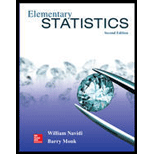
Ages of video garners: The Nielsen Company estimated the numbers of people in various gender and age categories who used a video game console. The results are presented in the following frequency distribution.
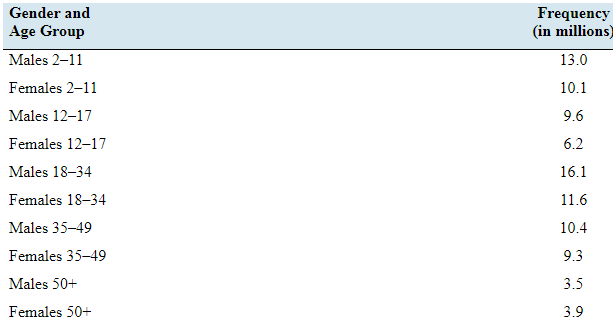
- Construct a frequency bar graph.
- Construct a relative frequency distribution.
- Construct a relative frequency bar graph.
- Construct a pie chart.
- True or false: More than half of video garners are male.
- True or false: More than 40% of video garners are female.
- What proportion of video garners are 35 or over?
a.
To construct: A frequency bar graph.
Explanation of Solution
Given information: The Nielson Company estimated the numbers of people in various gender and age categories who used a video game console. The results are presented in the following frequency distribution.
| Gender and age group | Frequency (in millions) |
| Males 2-11 | 13.0 |
| Females 2-11 | 10.1 |
| Males 12-17 | 9.6 |
| Females 12-17 | 6.2 |
| Males 18-34 | 16.1 |
| Females 18-34 | 11.6 |
| Males 35-49 | 10.4 |
| Females 35-49 | 9.3 |
| Males 50+ | 3.5 |
| Females 50+ | 3.9 |
Solution:
From the given table, the frequency bar graph is given by
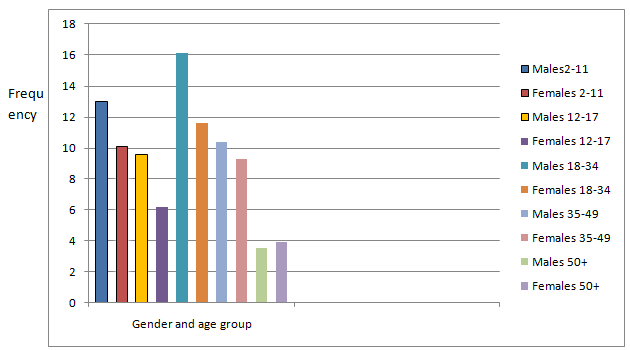
b.
To construct: The relative frequency distribution.
Explanation of Solution
Given information:The Nielson Company estimated the numbers of people in various gender and age categories who used a video game console. The results are presented in the following frequency distribution.
| Gender and age group | Frequency (in millions) |
| Males 2-11 | 13.0 |
| Females 2-11 | 10.1 |
| Males 12-17 | 9.6 |
| Females 12-17 | 6.2 |
| Males 18-34 | 16.1 |
| Females 18-34 | 11.6 |
| Males 35-49 | 10.4 |
| Females 35-49 | 9.3 |
| Males 50+ | 3.5 |
| Females 50+ | 3.9 |
Calculation:
From the given table,
The sum of all frequency is
The table of relative frequency is given by
| Gender and age group | Frequency (in millions) | Relative frequency |
| Males 2-11 | 13.0 | |
| Females 2-11 | 10.1 | |
| Males 12-17 | 9.6 | |
| Females 12-17 | 6.2 | |
| Males 18-34 | 16.1 | |
| Females 18-34 | 11.6 | |
| Males 35-49 | 10.4 | |
| Females 35-49 | 9.3 | |
| Males 50+ | 3.5 | |
| Females 50+ | 3.9 |
c.
To construct: A relative frequency bar graph.
Explanation of Solution
Given information:The Nielson Company estimated the numbers of people in various gender and age categories who used a video game console. The results are presented in the following frequency distribution.
| Gender and age group | Frequency (in millions) |
| Males 2-11 | 13.0 |
| Females 2-11 | 10.1 |
| Males 12-17 | 9.6 |
| Females 12-17 | 6.2 |
| Males 18-34 | 16.1 |
| Females 18-34 | 11.6 |
| Males 35-49 | 10.4 |
| Females 35-49 | 9.3 |
| Males 50+ | 3.5 |
| Females 50+ | 3.9 |
Definition used:
Histogram based on relative frequency is called relative frequency histogram.
Solution:
The Nielson Company estimated the numbers of people in various gender and age categories who used a video game console. The results are presented in the following frequency distribution.
| Gender and age group | Relative Frequency |
| Males 2-11 | 0.139 |
| Females 2-11 | 0.108 |
| Males 12-17 | 0.102 |
| Females 12-17 | 0.066 |
| Males 18-34 | 0.172 |
| Females 18-34 | 0.124 |
| Males 35-49 | 0.111 |
| Females 35-49 | 0.099 |
| Males 50+ | 0.037 |
| Females 50+ | 0.042 |
From the above table, the relative frequency bar graph is given by
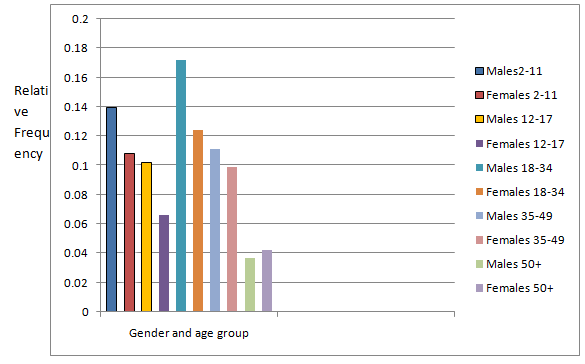
d.
To construct: A pie chart
Explanation of Solution
Given information: The Nielson Company estimated the numbers of people in various gender and age categories who used a video game console. The results are presented in the following frequency distribution.
| Gender and age group | Frequency (in millions) |
| Males 2-11 | 13.0 |
| Females 2-11 | 10.1 |
| Males 12-17 | 9.6 |
| Females 12-17 | 6.2 |
| Males 18-34 | 16.1 |
| Females 18-34 | 11.6 |
| Males 35-49 | 10.4 |
| Females 35-49 | 9.3 |
| Males 50+ | 3.5 |
| Females 50+ | 3.9 |
Solution:
From the given table, the percentage of each gender and age group is given by
| Gender and age group | Relative Frequency | Percentage |
| Males 2-11 | 0.139 | 13.9% |
| Females 2-11 | 0.108 | 10.8% |
| Males 12-17 | 0.102 | 10.2% |
| Females 12-17 | 0.066 | 6.6% |
| Males 18-34 | 0.172 | 17.2% |
| Females 18-34 | 0.124 | 12.4% |
| Males 35-49 | 0.111 | 11.1% |
| Females 35-49 | 0.099 | 9.9% |
| Males 50+ | 0.037 | 3.7% |
| Females 50+ | 0.042 | 4.2% |
From the above table, the pie chart is given by
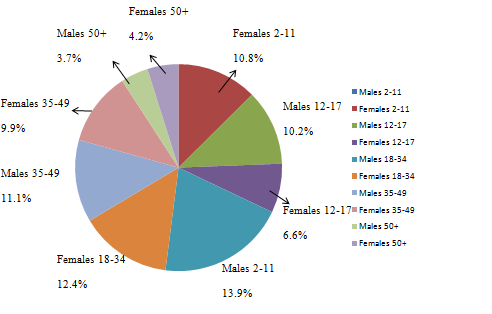
e.
True or False: More than half of video gamers are male.
Answer to Problem 25E
True.
Explanation of Solution
Given information:The Nielson Company estimated the numbers of people in various gender and age categories who used a video game console. The results are presented in the following frequency distribution.
| Gender and age group | Frequency (in millions) |
| Males 2-11 | 13.0 |
| Females 2-11 | 10.1 |
| Males 12-17 | 9.6 |
| Females 12-17 | 6.2 |
| Males 18-34 | 16.1 |
| Females 18-34 | 11.6 |
| Males 35-49 | 10.4 |
| Females 35-49 | 9.3 |
| Males 50+ | 3.5 |
| Females 50+ | 3.9 |
Solution:
The sum of all frequency is
The half of the frequency is 46.85.
The sum of total of male video gamer’s frequency is
Therefore, it is true that more than half of video gamers are male.
f.
True or False: More than 40% of video gamers are female.
Answer to Problem 25E
True.
Explanation of Solution
Given information:The Nielson Company estimated the numbers of people in various gender and age categories who used a video game console. The results are presented in the following frequency distribution.
| Gender and age group | Frequency (in millions) |
| Males 2-11 | 13.0 |
| Females 2-11 | 10.1 |
| Males 12-17 | 9.6 |
| Females 12-17 | 6.2 |
| Males 18-34 | 16.1 |
| Females 18-34 | 11.6 |
| Males 35-49 | 10.4 |
| Females 35-49 | 9.3 |
| Males 50+ | 3.5 |
| Females 50+ | 3.9 |
Solution:
The sum of all frequency is
40% of the total frequency is
The sum of total of female video gamer’s frequency is
Therefore, it is true that more than 40% of video gamers are female.
g.
To find: The proportion of video gamers is 35 or over.
Answer to Problem 25E
The proportion of video gamers is 35 or over is 0.289.
Explanation of Solution
Given information:The Nielson Company estimated the numbers of people in various gender and age categories who used a video game console. The results are presented in the following frequency distribution.
| Gender and age group | Frequency (in millions) |
| Males 2-11 | 13.0 |
| Females 2-11 | 10.1 |
| Males 12-17 | 9.6 |
| Females 12-17 | 6.2 |
| Males 18-34 | 16.1 |
| Females 18-34 | 11.6 |
| Males 35-49 | 10.4 |
| Females 35-49 | 9.3 |
| Males 50+ | 3.5 |
| Females 50+ | 3.9 |
Solution:
The sum of all frequency is
The sum of all frequency for which the video gamer is 35 or more is
The proportion of video gamers is 35 or over is given by
Therefore, the proportion of video gamers is 35 or over is 0.289.
Want to see more full solutions like this?
Chapter 2 Solutions
Elementary Statistics (Text Only)
- (a) Test the hypothesis. Consider the hypothesis test Ho = : against H₁o < 02. Suppose that the sample sizes aren₁ = 7 and n₂ = 13 and that $² = 22.4 and $22 = 28.2. Use α = 0.05. Ho is not ✓ rejected. 9-9 IV (b) Find a 95% confidence interval on of 102. Round your answer to two decimal places (e.g. 98.76).arrow_forwardLet us suppose we have some article reported on a study of potential sources of injury to equine veterinarians conducted at a university veterinary hospital. Forces on the hand were measured for several common activities that veterinarians engage in when examining or treating horses. We will consider the forces on the hands for two tasks, lifting and using ultrasound. Assume that both sample sizes are 6, the sample mean force for lifting was 6.2 pounds with standard deviation 1.5 pounds, and the sample mean force for using ultrasound was 6.4 pounds with standard deviation 0.3 pounds. Assume that the standard deviations are known. Suppose that you wanted to detect a true difference in mean force of 0.25 pounds on the hands for these two activities. Under the null hypothesis, 40 = 0. What level of type II error would you recommend here? Round your answer to four decimal places (e.g. 98.7654). Use a = 0.05. β = i What sample size would be required? Assume the sample sizes are to be equal.…arrow_forward= Consider the hypothesis test Ho: μ₁ = μ₂ against H₁ μ₁ μ2. Suppose that sample sizes are n₁ = 15 and n₂ = 15, that x1 = 4.7 and X2 = 7.8 and that s² = 4 and s² = 6.26. Assume that o and that the data are drawn from normal distributions. Use απ 0.05. (a) Test the hypothesis and find the P-value. (b) What is the power of the test in part (a) for a true difference in means of 3? (c) Assuming equal sample sizes, what sample size should be used to obtain ẞ = 0.05 if the true difference in means is - 2? Assume that α = 0.05. (a) The null hypothesis is 98.7654). rejected. The P-value is 0.0008 (b) The power is 0.94 . Round your answer to four decimal places (e.g. Round your answer to two decimal places (e.g. 98.76). (c) n₁ = n2 = 1 . Round your answer to the nearest integer.arrow_forward
- Consider the hypothesis test Ho: = 622 against H₁: 6 > 62. Suppose that the sample sizes are n₁ = 20 and n₂ = 8, and that = 4.5; s=2.3. Use a = 0.01. (a) Test the hypothesis. Round your answers to two decimal places (e.g. 98.76). The test statistic is fo = i The critical value is f = Conclusion: i the null hypothesis at a = 0.01. (b) Construct the confidence interval on 02/022 which can be used to test the hypothesis: (Round your answer to two decimal places (e.g. 98.76).) iarrow_forward2011 listing by carmax of the ages and prices of various corollas in a ceratin regionarrow_forwardس 11/ أ . اذا كانت 1 + x) = 2 x 3 + 2 x 2 + x) هي متعددة حدود محسوبة باستخدام طريقة الفروقات المنتهية (finite differences) من جدول البيانات التالي للدالة (f(x . احسب قيمة . ( 2 درجة ) xi k=0 k=1 k=2 k=3 0 3 1 2 2 2 3 αarrow_forward
- 1. Differentiate between discrete and continuous random variables, providing examples for each type. 2. Consider a discrete random variable representing the number of patients visiting a clinic each day. The probabilities for the number of visits are as follows: 0 visits: P(0) = 0.2 1 visit: P(1) = 0.3 2 visits: P(2) = 0.5 Using this information, calculate the expected value (mean) of the number of patient visits per day. Show all your workings clearly. Rubric to follow Definition of Random variables ( clearly and accurately differentiate between discrete and continuous random variables with appropriate examples for each) Identification of discrete random variable (correctly identifies "number of patient visits" as a discrete random variable and explains reasoning clearly.) Calculation of probabilities (uses the probabilities correctly in the calculation, showing all steps clearly and logically) Expected value calculation (calculate the expected value (mean)…arrow_forwardif the b coloumn of a z table disappeared what would be used to determine b column probabilitiesarrow_forwardConstruct a model of population flow between metropolitan and nonmetropolitan areas of a given country, given that their respective populations in 2015 were 263 million and 45 million. The probabilities are given by the following matrix. (from) (to) metro nonmetro 0.99 0.02 metro 0.01 0.98 nonmetro Predict the population distributions of metropolitan and nonmetropolitan areas for the years 2016 through 2020 (in millions, to four decimal places). (Let x, through x5 represent the years 2016 through 2020, respectively.) x₁ = x2 X3 261.27 46.73 11 259.59 48.41 11 257.96 50.04 11 256.39 51.61 11 tarrow_forward
- If the average price of a new one family home is $246,300 with a standard deviation of $15,000 find the minimum and maximum prices of the houses that a contractor will build to satisfy 88% of the market valuearrow_forward21. ANALYSIS OF LAST DIGITS Heights of statistics students were obtained by the author as part of an experiment conducted for class. The last digits of those heights are listed below. Construct a frequency distribution with 10 classes. Based on the distribution, do the heights appear to be reported or actually measured? Does there appear to be a gap in the frequencies and, if so, how might that gap be explained? What do you know about the accuracy of the results? 3 4 555 0 0 0 0 0 0 0 0 0 1 1 23 3 5 5 5 5 5 5 5 5 5 5 5 5 6 6 8 8 8 9arrow_forwardA side view of a recycling bin lid is diagramed below where two panels come together at a right angle. 45 in 24 in Width? — Given this information, how wide is the recycling bin in inches?arrow_forward
 Glencoe Algebra 1, Student Edition, 9780079039897...AlgebraISBN:9780079039897Author:CarterPublisher:McGraw Hill
Glencoe Algebra 1, Student Edition, 9780079039897...AlgebraISBN:9780079039897Author:CarterPublisher:McGraw Hill Holt Mcdougal Larson Pre-algebra: Student Edition...AlgebraISBN:9780547587776Author:HOLT MCDOUGALPublisher:HOLT MCDOUGAL
Holt Mcdougal Larson Pre-algebra: Student Edition...AlgebraISBN:9780547587776Author:HOLT MCDOUGALPublisher:HOLT MCDOUGAL Big Ideas Math A Bridge To Success Algebra 1: Stu...AlgebraISBN:9781680331141Author:HOUGHTON MIFFLIN HARCOURTPublisher:Houghton Mifflin Harcourt
Big Ideas Math A Bridge To Success Algebra 1: Stu...AlgebraISBN:9781680331141Author:HOUGHTON MIFFLIN HARCOURTPublisher:Houghton Mifflin Harcourt


